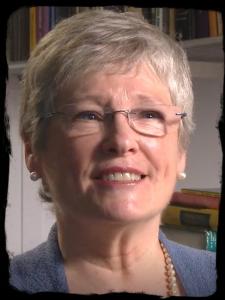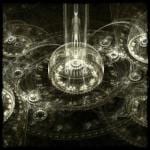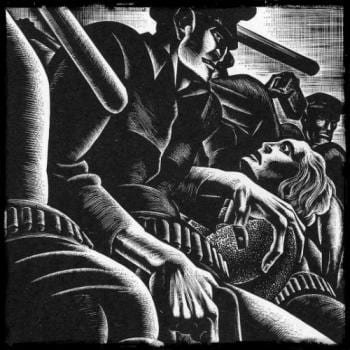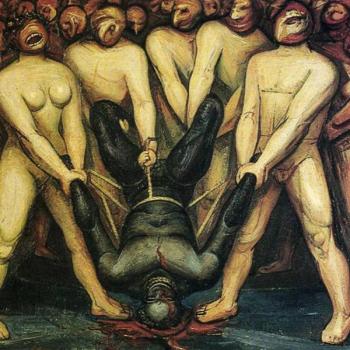This article originally appeared on the Ploughshares Fund website. For nearly 40 years, Ploughshares Fund has supported the most effective people and organizations in the world to reduce and eventually eliminate the dangers posed by nuclear weapons. Since 1981, Ploughshares Fund has distributed nearly $100 million in grants to organization such as the Bulletin of the Atomic Scientists, Physicians for Social Responsibility, and the William Perry Project. Please consider donating to the Ploughshares Fund.

When Kennette Benedict joined the board of the Ploughshares Fund in 2012, she was Executive Director and Publisher of Bulletin of the Atomic Scientists, at the apex of a distinguished professional career devoted to spotlighting the existential risks of nuclear weapons and reducing the likelihood they might ever be used.
While I had never previously spoken with Kennette, I had known of her for more than 30 years. In the early 1980s, my wife was a misfit young graduate student in the political science department at the University of Illinois in Urbana-Champaign, where Kennette was at the time herself a young assistant professor. My wife befriended Kennette, and as she later told me (over and over again), Kennette’s friendship anchored, sustained, and stabilized her in a rural midwestern outpost that was otherwise entirely alien to her.
For this reason, I had high expectations for my recent conversation with Kennette, and she did not disappoint. Staring directly into the nuclear heart of darkness, year after year, is not work for the faint of heart, but like other women who have for decades been part of the arms control and international security community, Kennette has consistently brought a steady voice to the conversation, a gracious manner and ready wit, layered upon an acute intelligence and unwavering resolve. In these years of service, Kennette has also emerged as an important source of institutional memory for the history of international arms control, and the role played by the international science community, in the decades following military use of the first atomic weapons in August 1945.
Civil Rights and Nuclear Wrongs
The child of social justice activists who spent their lives fighting racism and poverty, Kennette was born in East Harlem, where her parents had founded the East Harlem Protestant Parish, a ministry for the poor in a neighborhood more densely populated at the time than Calcutta. In 1954, her family moved to Cleveland, where her father set up with colleagues another parish on both the east and west sides of Cleveland to bring white and black communities together—again living in poor communities, helping those suffering from alcoholism and drug abuse, and trying to address the harms of racial segregation. Kennette’s family moved to Chicago when she was 12 years old. Her father continued to work with black leaders, raising money from white churches to invest in Chicago’s south and west side communities. “That was all formative,” Kennette says, “and I owe them a lot for the vision and sense of mission that they imparted from my earliest days growing up.”
As Kennette reminded me, she did not have a background in international relations when she taught at the University of Illinois. She had received a B.A. in government from Oberlin College and a Ph.D. from Stanford, with dissertation supervision from famed behavioral social scientists James G. March and Heinz Eulau. At the University of Illinois, Kennette taught classes on organizational behavior and American politics (with a special emphasis on women and leadership). But in 1987, following the birth of her daughter, she took a position in Chicago with the John D. and Catherine T. MacArthur Foundation, working with Ruth Adams, who was at the time a major force in the field of nuclear disarmament and international security. “Because of the way Ruth Adams talked about many of these international security issues,” Kennette says, “I felt pretty much at home, because it was about how to develop international cooperation relations with people, right the wrongs of this nuclear buildup and arms race.”
In her early years at MacArthur, Kennette was privileged also to work with Jerome Wiesner, Murray Gell-Mann, Jonas Salk, and John Holdren, four of the world’s most renowned scientists. What followed, Kennette says, was “18 years of what I guess would be called an extraordinary seminar.” As Kennette describes these years, “I was able to talk to some of the most brilliant people in the world, most committed, not only to nuclear disarmament, but to international peace and cooperation. So, the experience was really inspiring to me. And I think it motivated me to learn as much as I could, not only about nuclear issues but about broad issues of international security.”
Kennette arrived at the MacArthur Foundation at the beginning of the end of the Cold War and was there during the very exciting period following the fall of the Berlin Wall. In 1992, Kennette assumed responsibility for MacArthur’s Program on Peace and International Security, which issued upwards of $25 million annually in grants addressing global security and sustainability, including nuclear weapons disarmament and nonproliferation, violent conflict, human rights, globalization and governance, population, and the environment. At the same time, she also directed the Chicago and Moscow offices for MacArthur’s Initiative in the former Soviet Union, with a total grantmaking authority, over a ten-year period, of over $50 million to support Soviet, and then Russian, institutions and individuals in scientific and intellectual communities, with a focus on human rights, law and society, environment, regional peace and security, and higher education.
Conscience of the Scientific Community
Kennette was named Executive Director and Publisher of Bulletin of the Atomic Scientists in 2005. The Bulletin had been founded in 1945 by some of the early atomic weapons scientists who had worked together at the Manhattan Project’s famed Metallurgical Lab at the University of Chicago, most notably, James Franck, Leo Szilard, Eugene Rabinowitch, John Simpson, and Hyman Goldsmith. In what became known as the Franck Report, written in June 1945, these scientists made the case for civilian control of nuclear weapons and argued against military use of atomic weapons against Japan. In the aftermath of World War II, aware that the military, and the US government, was trying to draw a veil of secrecy across these weapons, and being scientists and internationalists and people who believed in democracy, Rabinowitch, Simpson, and Goldsmith founded the Bulletin “to tell the public about the danger of the weapons, how terrible they are, what the effects are on people, how these weapons were being used, and especially in the United States that they were being used in our name.”
Kennette emphasizes the cultural impact of the Bulletin, which in the decades of the Cold War came to be viewed by many, not simply as a trusted source of facts about nuclear weapons, but as the conscience of the scientific community. The Bulletin’s reach also extended well beyond concerns about nuclear weapons. As Kennette notes, “The Bulletin was publishing articles in the late 1950s about the effects of carbon dioxide on the atmosphere, on climate, for instance. So, they’ve been interested, not only in nuclear weapons, but in other kinds of technologies that could have really profound consequences for humanity.”
The Doomsday Clock
Of course, when most people think about Bulletin of the Atomic Scientists, they visualize the Doomsday Clock, which has through the decades, particularly during the Cold War, served as a remarkable example of how a symbol can crystallize and elevate awareness and capture the popular imagination. As Kennette tells the story, in 1947 the Bulletin needed a design for the first cover of what was to become the magazine, and co-editor Hyman Goldsmith turned for help to a young landscape artist named Martyl Langsdorf, who was married to University of Chicago physicist, Alexander Langsdorf and a member of the close-knit community of Chicago scientists clustered in and around Hyde Park.
2019 Doomsday Clock Announcement from www.thebulletin.org on Vimeo.
Martyl initially played around with designs to symbolize uranium, but as she listened to the conversations about the power of the atom that were taking place across the campus, she heard the sense of urgency, the shared conviction among scientists that the risks of a nuclear arms race were rapidly mounting as the Cold War with the Soviet Union hardened and deepened. “And so she came up with the idea of a clock. And she did the last quadrant of a clock, which combined images of urgency, of a kind of apocalyptic midnight, along with a countdown.”
Interestingly, the initial detonation test of the bomb itself represents one of the first known uses of a countdown – ten, nine, eight, seven, six – as we now customarily use and invoke the word. Bulletin editor Eugene Rabinowitch published an essay in 1953 that used the phrase “clock of doom,” and the name “Doomsday Clock” has been used ever since to identify the image.
Repair and Renewal at The Bulletin
A magazine is like a living creature, subject to a limited lifespan and under any circumstances vulnerable to some combination of financial precarity, technical obsolescence, or historical irrelevance. And so when Victor Rabinowitch (son of Eugene Rabinowitch) in 2005 urged Kennette to assume the leadership role at the Bulletin of the Atomic Scientists, Kennette remembers, “I was, frankly, a bit dubious at first. But as I looked more deeply into its history, and into the communication aspect of it, I became much more convinced that the Bulletin was really more necessary than ever. So, I took the leap and went from the MacArthur Foundation to the Bulletin in 2005 and found another home. It was a completely invigorating experience.”
At that time, the Bulletin had been publishing for 60 years, a long period for any magazine to exist without requiring several (if not more) sustained cycles of repair and renewal. Like many other institutions that came into existence immediately following World War II, the Bulletin was also trying to find its way in the post-Cold War era, particularly after 9/11, with the war on terrorism very much the focus of attention. Kennette recalls the circumstances. “The Bulletin needed funding. It needed a new editorial mission and vision. And so I was asked to bring it back to, or at least try to bring it back to, its previous glory.”
Kennette determined to restore the Bulletin its original editorial mission, as a magazine that directly connected the trusted authority of the scientific community to a broad public concerned with the dangers of nuclear weapons and need for nuclear disarmament, but also with attention to the existential implications of climate change and disruptive new technologies in biology and in artificial intelligence.
As Kennette remembers this decision, “Sometimes, when you try to think anew about something, going back to history can help you anchor your mission, reinvigorate it, and take the idea that was there and simply give it some new blood and new orientation. And I think the original idea behind the Bulletin was so strong, and so needed today. If you look at the history of the Bulletin, in the back issues, you could see that scientists were wanting to grapple with a whole range of science and technology issues that they felt had untoward consequences for humanity as well as beneficial ones. So that was where I started and felt that we could turn the Bulletin again into a place where scientists and other experts could speak directly to the public.”
A Community of Scientists
Many of the scientists who founded the Bulletin had been born in Europe, and from the beginning the scientific community that organized the anti-nuclear movement possessed a cosmopolitan, international flavor that transcended national borders. More acutely, perhaps, than any other group of people alive at the time, in a period of rapid decolonization and new nation-state formation, this community of international scientists recognized the risks of “nationalizing” nuclear weapons as instruments of wars that might in any way be viewed as winnable.
From the earliest stages of her career at the MacArthur Foundation, Kennette rubbed shoulders and worked closely with some of the most influential members of this international community of activist scientists, deeply impressing upon her the early importance of international publications and conferences, such as the Bulletin and Pugwash Conferences on Science and World Affairs, and of scientists and mathematicians of international renown in the postwar years such as Joseph Rotblat and Frank von Hippel, who sacrificed years from their own careers to the cause of nuclear disarmament.
In more than three decades with organizations pursuing the goals of international peace and security, Kennette herself has played a role in mediating and fashioning similar international connections and relationships between the MacArthur Foundation, Bulletin of the Atomic Scientists, and Ploughshares Fund, and has helped to preserve to this day the unique sensibility and imagination at work in the international community of scientists in the postwar decades.
Of this tightly connected anti-nuclear ecosystem Kennette says, “It’s a real boon to have people who share the same values and share a sense of mission and share a sense of the priorities, especially when it comes to nuclear weapons. It’s a field that is generally underfunded, underappreciated, even maybe underimagined in some ways. But to have people who are dedicated, who know one another, who can work well together because of that set of shared understandings and shared history, I think can be very powerful.”
Women: They Get the Job Done
Nuclear physics is a field dominated by men. Kennette’s attunement to the “sense of urgency” about nuclear weapons and about climate change is a testament to the fact that a female perspective is extremely vital to this issue and has been there all along. Dating back to the 1970s and before, women such as Helen Caldicott had been leaders in the disarmament movement. At the end of the Cold War, in the late 1980s and into the early 1990s, women such as Rose Gottemoeller, Liz Sherwood Randall, Gloria Duffy, Jessica Stern, Gael Tarleton (and, of course, Kennette, herself, at the MacArthur Foundation) each played critical roles in working with Russia and other nations formerly part of the Soviet Union to secure and consolidate the control of Eastern Bloc nuclear weapons.
In echoes of the Lin-Manuel Miranda’s refrain from Hamilton the Musical, “Immigrants: we get the job done,” Kennette reminds us, “Women have always been there. They’re wildly competent and get thing done. Think of the new START agreement. Rose Gottemoeller was Undersecretary of State for Arms Control and International Security. She was fluent in Russian. She had been in this field for many years. She was also part of Pugwash. And so, when it came time to find somebody to negotiate with the Russians the new START agreement, she was it. When the Iran deal was negotiated, Wendy Sherman was it. They’re the people who get the work done. So yes, I’m glad there’s now more recognition and I hope that it will encourage other younger women. When I look at some of my students, I think many more of them are getting interested and see a role for themselves because they see these women now more visibly.”
Kennette’s Ploughshares Fund Relationship
Kennette joined the Ploughshares Fund board in 2012 because “Ploughshares is one of the only, if perhaps the only, foundation dedicated to nuclear disarmament. At the MacArthur Foundation, I led a program that was in part supporting work on nuclear disarmament. But it was only one program of many at the MacArthur Foundation, So the idea of joining a group of people who are really dedicated to nuclear issues and trying to solve the problem of nuclear weapons was very appealing to me.”
Interestingly, MacArthur had often depended on Ploughshares Fund, especially in the chaotic days following the end of the Cold War, to surface and spotlight projects MacArthur themselves might want to fund. Kennette remembers, “MacArthur could put some greater amount of dollars in, but often Ploughshares was first out of the box, and could experiment and then see what came of those experiments. Then we would come in with more money.”
Kennette has especially appreciated Ploughshares Fund’s focus on heightened risks and dangers of conflict when regional powers acquire nuclear weapons. Ploughshares Fund actively and effectively advocated with Congress for the JCPOA agreement with Iran that exchanged the lifting of sanctions for verifiable commitments from Iran not to develop nuclear weapons. Ploughshares Fund also has helped to frame discussion of nuclear weapons programs in North Korea with reference to the unique politics of the Korean peninsula.
Kennette also marvels at the extraordinary skill with which Ploughshares Fund, a small organization, can so adeptly, and in concert, perform three very different nonprofit functions: award grants, act as a spokesperson, and raise money. “Ploughshares has the expertise, and knows how to communicate to the public, and so it can reach out and solicit donations and get people excited and interested enough to give on these issues. Ploughshares is alone in the field in combining those things so we can educate and activate people to focus on the problem of nuclear weapons and nuclear disarmament.”
The Truth Will Set You Free. But First It Will Make You Miserable
Mindful that meaningful change does not happen in a straight line, and so requires hard work without any guaranteed outcome on any predictable timeline, Kennette draws strength and comfort from the hard choices and paths her parents chose in their own efforts to right historic wrongs. As with efforts to fight poverty and racism, Kennette knows that nuclear disarmament will require a new level of spiritual engagement, that humans will need to “change their consciousness and understanding about nuclear weapons and get rid of the idea that they can be used for deterrence, because if deterrence fails it will mean more fighting, and we can’t have nuclear wars, or we won’t exist anymore.”
The tools for achieving a change in consciousness are empathy, education, and an understanding of history. We truly do know the answer to this question. As Kennette points out, the way we think about landmines, and about chemical and biological weapons, has changed over time. We no longer consider use of these weapons to be legitimate or lawful. A similar outcome can be achieved with nuclear weapons. They need to be DE-legitimized in some fashion.
Kennette points in particular to the International Campaign to Abolish Nuclear Weapons, working with the UN to ratify a treaty to abolish nuclear weapons, for which they were awarded the Nobel Peace Prize in 2017. Kennette also spoke about the young people in her classes at the University of Chicago, many of whom are understanding for the first time the importance of politics, which in a way she suggests, might simply be another word for “paying attention.”
“They are familiar with nuclear weapons. Every video game has someone nuking somebody or other. It’s in their consciousness. But the effects of these weapons, what they will do, is not in their consciousness. But when it’s presented to them in a more personal, quiet way, they seem to get it. So, I’m hopeful that because the times are so terrible, that people are realizing they can’t sit back, they need to get involved, and they need to, on the basis of social justice, really, to work to change the world.”
Kennette sighs and laughs as our conversation closes. “It is difficult to teach this course every year,” she says. “I tell the students at the beginning, ‘The truth shall set you free. I will give you the truth. But first of all, it will make you miserable.’ And I tell them right up front, this is not fun stuff. This is difficult, hard and extremely worthwhile. And some of them seem to think so at the end.”
Please consider donating to the Ploughshares Fund.












